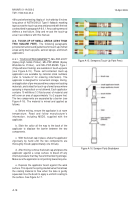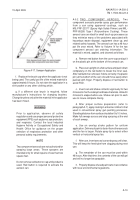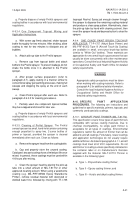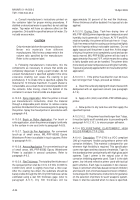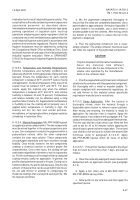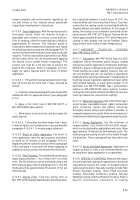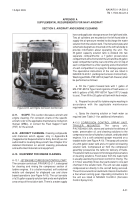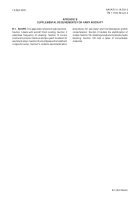TM-1-1500-344-23-2 - Page 197 of 240
A-27
NAVAIR 01-1A-509-2
TM 1-1500-344-23-2
15 April 2009
evaluation by the local Industrial Hygiene activity. This
area shall be sufficiently isolated to prevent exposure to
unprotected personnel, as described above.
Intermediate maintenance activity production-type spray
painting operations or squadron paint touch-up
operations employing paint spray equipment shall be
conducted only in well ventilated areas approved by the
local Industrial Hygiene activity and in accordance with
pertinent environmental regulations. Routine Industrial
Hygiene evaluations must be obtained by contacting
the Occupational Health Office or Medical Clinic. Each
facility will maintain a hard copy of the initial and periodic
industrial hygiene evaluation. Refer to OPNAVINST
5100.23 for frequency of Industrial Hygiene Evaluations/
Surveys.
A-10.5.3. Temperature and Humidity Requirements.
Extreme temperature and humidity conditions will
adversely affect film-forming properties of polyurethane
topcoats. Ensure the temperature for each coating
component is between 60
°
F and 90
°
F before mixing
and application. Surface temperature of the area to be
coated must be between 60
°
F and 90
°
F. For best
results, apply this material only when the ambient
temperature is between 60
°
F and 90
°
F, and relative
humidity is between 30 and 75 percent. Temperature
and relative humidity can be obtained using a sling
psychrometer (Volume IV). If applied when temperature
or humidity is low, the coating will not properly cure. If
applied when temperature or humidity is high, the
coating will dry too fast and exhibit pinholes,
microblisters, or hazing in gloss films, and gloss variation
(streaking) in lusterless films.
A-10.5.4. Material Preparation. MIL-PRF-85285 topcoat
is supplied as a two component kit. The two components
must be mixed together in the proper proportions prior
to use. One component contains the pigment within a
polyurethane vehicle, while the other component
contains the clear resin solution. These components
are packaged separately and have excellent storage
stability. Once mixed, however, the two components
undergo a chemical reaction to achieve proper film
characteristics. Over a few hours, the coating will gel
and harden regardless of whether or not it is exposed to
air. Pot life is a measure of the length of time a catalyzed
coating remains useful for application. In general, the
pot life of polyurethane topcoat is 4 hours. During hot or
humid conditions, the pot life will decrease. Only mix the
amount of material that can be used within two hours.
Do not add thinner to attempt to compensate for
thickened coatings that are beyond useful pot life. Mix
the topcoat as follows:
a. Mix the pigmented component thoroughly to
ensure that the solids are completely dispersed. Use a
paint shaker for approximately 10 minutes if possible. If
a paint shaker is not available, use a clean metal or
wooden paddle to stir the contents. After mixing, check
the bottom of the container to ensure that all of the
pigment is dispersed.
b. Pour the pigmented component into a clean,
empty container. The empty container must be at least
two times the capacity of the pigmented component.
CAUTION
Only mix materials from the same manufacturer.
Never mix materials from different
manufacturers. Mix the two components in the
volume ratio specified by the manufacturer.
Refer to the container label.
c. Pour the required amount of clear resin component
slowly into the container with the pigmented component.
Stir thoroughly with a metal or wooden paddle. To
remain compliant with environmental regulations, do
not add thinner to this material unless specifically
required per manufacturer’s instructions.
A-10.5.5. Spray Application. After the topcoat is
thoroughly stirred, strain the material through a
disposable paint strainer to remove coarse particles.
After mixing and straining, the material is ready for
application. No induction time is required. Spray the
mixed topcoat in accordance with paragraph A-8. Two
coats are necessary to achieve adequate film thickness.
The first coat shall be a light (mist) coat. Allow the first
coat to set for 30 to 60 minutes before applying the
second coat to permit solvent evaporation. The second
coat shall be a full wet coat to achieve the desired film
thickness (refer to paragraph A-10.5.9). Apply
MIL-PRF-85285 topcoat within 24 hours of primer
application.
A-10.5.5.1. If the primer has been allowed to dry longer
than 24 hours but not more than 7 days, proceed as
follows:
a. Clean the surface by wiping with clean cheesecloth
dampened with an approved solvent (see paragraph
A-7.4).
b. Apply a thin (mist) coat of MIL-PRF-23377 or
MIL-PRF-85582 epoxy primer.
c. Allow primer to dry tack-free and then apply the
specified topcoat.
Back to Top


